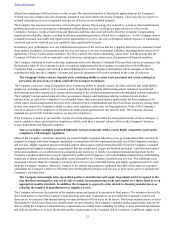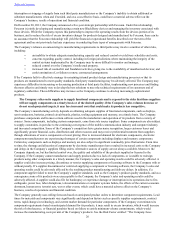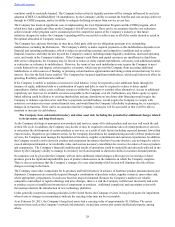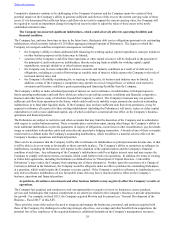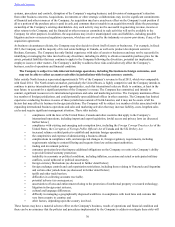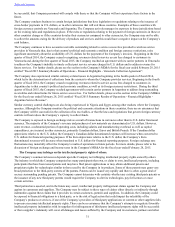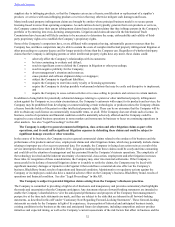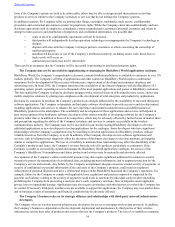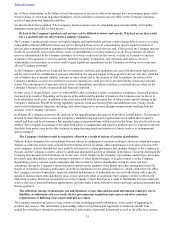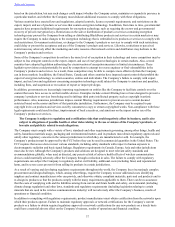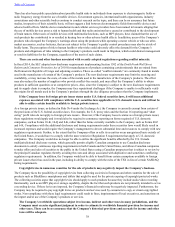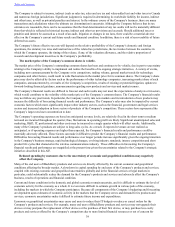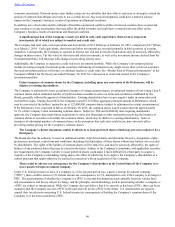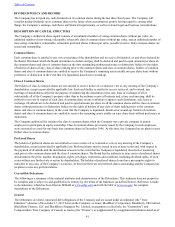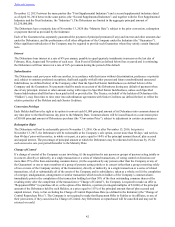Blackberry 2015 Annual Report Download - page 44
Download and view the complete annual report
Please find page 44 of the 2015 Blackberry annual report below. You can navigate through the pages in the report by either clicking on the pages listed below, or by using the keyword search tool below to find specific information within the annual report.
Table of Contents
35
any of these relationships, or the failure of such third parties to execute or effectively manage their own business plans, could
result in delays or reductions in product shipments, which could have a material adverse effect on the Company’s business,
results of operations and financial condition.
See also the Risk Factor entitled “The Company's products and services are dependent upon interoperability with rapidly
changing systems provided by third parties”.
Defects in the Company’s products and services can be difficult to detect and remedy. If defects occur, they could
have a material adverse effect on the Company’s business.
The Company’s products and services are highly complex and sophisticated and may contain design defects, errors or security
vulnerabilities that are difficult to detect and correct. Design defects, errors or vulnerabilities may be found in products or
services after commencement of commercial shipments or provision of such services and, if discovered, the Company may not
be able to successfully correct such defects, errors or vulnerabilities in a timely manner or at all. The occurrence of defects,
errors or vulnerabilities in the Company’s products or services could result in the loss of, or delay in, customer or end user
acceptance of its products or services and may harm the Company’s reputation, and correcting such defects, errors or
vulnerabilities in its products or services could require significant expenditures by the Company, involving cost or time and
effort of Company personnel.
As the Company’s products are integrated into its customers’ networks and equipment, are used with third party applications
and are used to deliver confidential or personal information, the sale and support of these products and services may entail the
risk of liability due to product liability, warranty or other claims tied to the security of data. In addition, the failure of the
Company’s products or services to perform to end user expectations could give rise to product liability claims and warranty
claims. The consequences of any such defects, errors, vulnerabilities and claims could have a material adverse effect on the
Company’s business, results of operations and financial condition.
In some cases, if design defects, errors or vulnerabilities affect a product’s safety or regulatory compliance, then such product
may need to be recalled. Depending on the nature of the defect and the number of products, the Company may be forced to
incur substantial recall costs, in addition to the costs associated with the potential loss of future orders and the damage to the
Company’s reputation. Recalls involving regulatory agencies could also result in fines and additional costs. Finally, recalls
could result in third-party litigation, including class action litigation by persons alleging common harm resulting from the
purchase of the Company’s products.
In addition, the Company outsources the majority of the manufacturing and repair of its products to third parties. The resources
devoted by these third parties to meet the Company’s manufacturing and repair requirements is not within the Company’s
control and there can be no assurance that manufacturing or repair problems will not occur in the future. See also the risk factor
entitled “The Company increasingly relies upon third parties to manufacture and repair its products and it is exposed to the risk
that these third parties may not be able to satisfy its manufacturing needs and repairs on a timely basis or to an appropriate
quality standard”.
The Company’s business could be negatively affected as a result of actions of activist shareholders.
Publicly-traded companies have increasingly become subject to campaigns by investors seeking to advocate certain governance
changes or corporate actions such as financial restructuring, special dividends, share repurchases or even sales of assets or the
entire company. Activist shareholders have publicly advocated for certain governance and strategic changes at the Company in
the past, and the Company could be subject to additional shareholder activity or demands in the future. Given the challenges the
Company has encountered in its business in recent years, recent changes to the Company’s governance and strategic focus may
not satisfy such shareholders who may attempt to promote or effect further changes, or acquire control over the Company.
Responding to proxy contests, media campaigns and other actions by activist shareholders would be costly and time-
consuming, disrupt the Company’s operations and would divert the attention of the Board and senior management from the
pursuit of its business strategies, particularly its ability to implement its new strategic initiatives, which could adversely affect
the Company’s results of operations, financial condition and prospects. If individuals are elected to the Board with a specific
agenda to increase short-term shareholder value, it may adversely affect or undermine the Company’s ability to effectively
implement its plans. Perceived uncertainties as to the Company’s future direction as a result of shareholder activism could also
result in the loss of potential business opportunities, and may make it more difficult to attract and retain qualified personnel and
business partners.
The collection, storage, transmission, use and disclosure of user data and personal information could give rise to
liabilities or additional costs as a result of laws, governmental regulations and carrier and other customer
requirements or differing views of personal privacy rights.
The Company transmits and stores a large volume of data, including personal information, in the course of supporting its
products and services. This information is increasingly subject to legislation and regulations in numerous jurisdictions
around the world that is intended to protect the privacy and security of personal information as well as the collection, storage,


